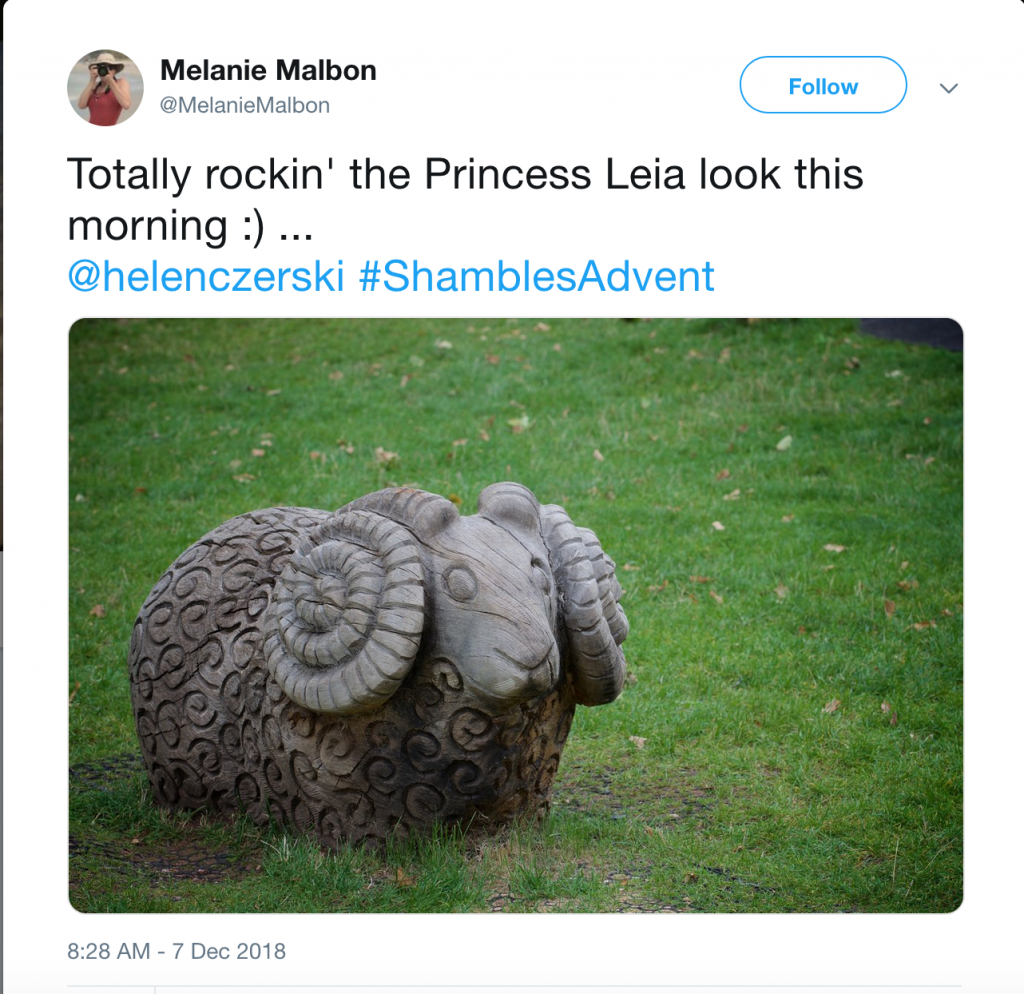Day 18 - Shambles Advent
Blog in a Teacup by Dr Helen CzerskiDay 18 – @MelanieMalbon
Every day until Christmas Dr Helen Czerski will be finding some cool, hidden science in pics of people’s every day lives. To get involved, tweet your pic to @helenczerski and @cosmicshambles with the hashtag #ShamblesAdvent

Today’s photo was sent by @MelanieMalbon , and I love this slightly grumpy-looking sheep. I can’t tell how long it’s been there, but the deep cracks make it look as though it’s been parked in that field for quite a long time. We take it for granted that wood cracks with age but it’s not obvious that it should. Wood looks solid. Why would it change shape?
The headline reason is astonishing enough in itself – when you first chop down a tree, a gigantic 50% of the mass of that wood can be water. Some of it is there because the living part of a tree trunk is the plumbing of the tree. A tree trunk is a mass of very fine pipework, and when the tree is standing those pipes are full of water. But some of that water has sneaked its way deep into the fabric of the wood and has snuggled up next to the main building block of the tree: cellulose. Water binds very easily to cellulose, but it’s a fickle friend. If the environment dries out, the bonds with the water will break, and the water will evaporate back into the atmosphere. As the water leaves, the wood shrinks because there’s less stuff to fit in. But if a wet day comes again, it will expand back towards its original size.
Perhaps that’s not so surprising, but it hasn’t explained the cracks yet. The wood will all dry out at the same rate, so why would it crack as it shrinks? If you look again at the sheep, you can see that the cracks are all lined up. If you draw an imaginary line from the sheep’s nose to its tail, through its middle, it looks as though the cracks are radiating out from the centre towards the edges. Wood doesn’t crack randomly. If you imagine a disk of wood cut from a tree trunk, the cracks will always go from the centre to the outside.
I think that this sheep was carved from a thick slice of tree trunk because its cracks follow this same pattern. The up-down direction on the tree was the nose-tail direction on the sheep. It turns out that wood shrinks very little in this direction as it dries, so our sheep will stay the same length. Then there’s the radial direction, from inside the sheep’s tummy to the top of its back. There is shrinkage in this direction, a little bit, so the sheep will get a bit slimmer as it dries out. But the big difference comes as you travel around the outside of the trunk, or around the sheep’s tummy (as if it was wearing a belt). This is the dominant direction of shrinkage, and the cracks are pulling the outer layer apart because it isn’t long enough to reach all the way around any more. The reason for the cracks is that the shrinkage in these three directions is dramatically different, and that’s down to the shape of the cells the tree is made up of.
When it rains, our grumpy friend will take up water again and the cracks will close up ever so slightly. Wood is continually adjusting its water content in response to the surroundings, and it’s never “just” wood – it always carries the signature of the tree it once was.
Read all of Helen’s other #ShamblesAdvent entries here
The Cosmic Shambles Network relies on your support on pledges via Patreon so we can continue to provide great, new, exciting content without the need for third party ads or paywalls.
For as little as $1 a month you can support what we do and get some great rewards for doing so as well. Click the Patreon logo to pledge or find out more.
 Dr Helen Czerski is a physicist, first and foremost, but she’s acquired a few other labels along the way: oceanographer, presenter, author and bubble enthusiast. A regular on The Cosmic Shambles Network, she has also presented a number of acclaimed documentaries for the BBC and her first book, Storm in a Teacup, which looked at the physics of every day things, was a bestseller. Recently she was awarded the prestigious William Thomson, Lord Kelvin Medal and Prize from the Institute of Physics.
Dr Helen Czerski is a physicist, first and foremost, but she’s acquired a few other labels along the way: oceanographer, presenter, author and bubble enthusiast. A regular on The Cosmic Shambles Network, she has also presented a number of acclaimed documentaries for the BBC and her first book, Storm in a Teacup, which looked at the physics of every day things, was a bestseller. Recently she was awarded the prestigious William Thomson, Lord Kelvin Medal and Prize from the Institute of Physics.
If you would like to reuse this content please contact us for details
Subscribe to The Cosmic Shambles Network Mailing list here.


